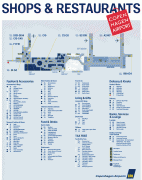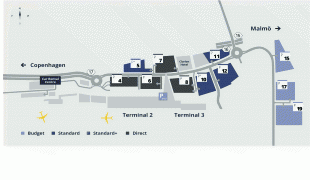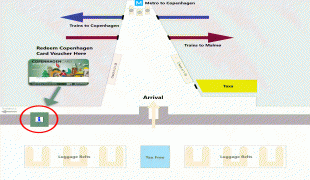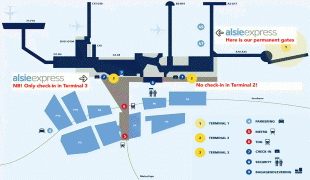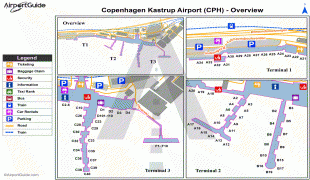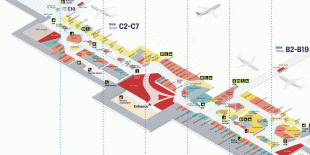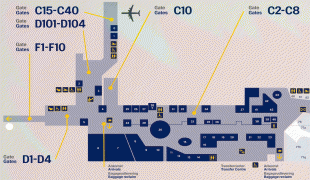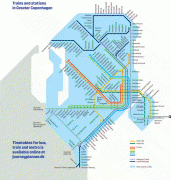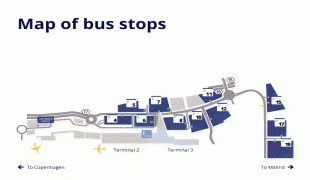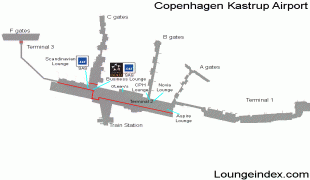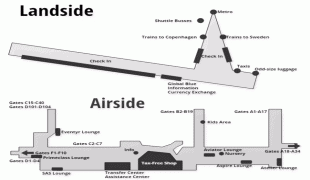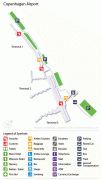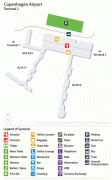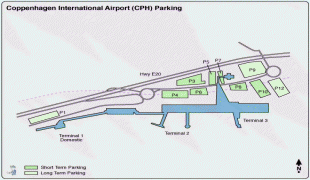Copenhagen Airport (Copenhagen Airport)
Copenhagen Airport, Kastrup (Københavns Lufthavn, Kastrup, ; ) is an international airport serving Copenhagen, Denmark, Zealand, the Øresund Region, and southern Sweden including Scania. It is the second largest airport in the Nordic countries.
As of 2019, the airport was the largest airport in the Nordic countries with close to 30.3 million passengers. It is one of the oldest international airports in Europe, the fourth-busiest airport in Northern Europe, and the busiest for international travel in Scandinavia.
The airport is on the island of Amager, 8 km south of Copenhagen city centre, and 24 km west of Malmö city centre, to which it is connected by the Øresund Bridge. The airport covers an area of 11.8 km2. Most of the airport is in the municipality of Tårnby, with a small part in the city of Dragør.
The airport is the main hub out of three used by Scandinavian Airlines and is also an operating base for Sunclass Airlines and Norwegian Air Shuttle. Copenhagen Airport handles around 60 scheduled airlines, and has a maximum operation capability of 83 operations/hour, and a total of 108 jet bridges and remote parking stands. Unlike other Scandinavian airports, most of the airport's passengers are international. In 2015, 6.1% of passengers travelled to and from other Danish airports, 83.5% to/from other European airports, and 10.4% were intercontinental passengers. The airport is owned by Københavns Lufthavne, which also operates Roskilde Airport. The airport employs 1,700 people (not including employees in shops, restaurants, etc.).
Copenhagen Airport was originally called Kastrup Airport, after the small town of Kastrup, now part of the Tårnby municipality. The formal name is still Copenhagen Airport, Kastrup, to distinguish it from Roskilde Airport.
The airport was inaugurated 20 April 1925 and was one of the first civil airports in the world. It consisted of a large, impressive terminal built of wood, a couple of hangars, a balloon mast, a hydroplane landing stage and a few grassy meadows that could be used as runways. The grass on the runways was kept short by sheep, which were shepherded away before take-offs and landings. From 1932 to 1939, takeoffs and landings increased from 6,000 to 50,000 and passenger number increased to 72,000. Between 1936 and 1939, a new terminal was built, considered one of the finest examples of Nordic functionalism. The terminal was designed by Vilhelm Lauritzen, who was considered a pioneer among architects, in terms not only of architecture and construction, but also of service and passenger comfort.
In the years of World War II, the Copenhagen airport was closed for civil operations except for periodic flights to destinations in Sweden, Germany, and Austria. In the summer of 1941 the first hard-surface runway opened. It was 1400 m long and 65 m wide. When World War II ended in May 1945, Copenhagen had the most modern international airport in Europe, because the airport remained untouched by actual acts of war.
On 1 August 1947, Scandinavian Airlines (SAS) was founded, an important event for the Copenhagen Airport, as Copenhagen was to be the main hub for the airline. Traffic increased rapidly in the first years SAS operated. On 26 January 1947, a KLM Douglas DC-3 "Dakota" crashed at the airport after stopping en route to Stockholm. 22 people on board died, including the Swedish prince Gustav Adolf and the American opera singer Grace Moore. In 1948, Copenhagen airport was third largest airport in Europe with 150 daily takeoffs and almost 300,000 passengers for the year. The airport continued its rapid growth. The terminal was expanded several times and new hangars were erected.
In 1954, Scandinavian Airlines begins the world's first trans-polar route, flying initially to Los Angeles. The route proved to be a publicity coup, and for some years Copenhagen became a popular transit point for Hollywood stars and producers flying to Europe – also the airport handled 11,000 tonnes of freight per year. In 1956, the airport handled 1 million passengers per year and won the award for the world's best airport. The runways were lengthened and fitted with technically advanced equipment.
By 10 May 1960, when the new airport terminal (now Terminal 2) was inaugurated, the daily number of jet operations had increased to 28, and still traffic kept on growing. The large new airport terminal soon became too small, and in 1969 yet another huge expansion programme was launched. Domestic traffic was relocated to a new domestic terminal (the eastern part of Terminal 1). The (current) international terminal was supplemented with a new pier (C) and a separate arrivals hall (the building between Terminals 2 and 3). A new control tower and 3600 m of additional runways allowed take-offs and landings to take place at the same time. When the comprehensive expansion was completed in 1972, the number of take-offs and landings exceeded 180,000 and there were more than eight million passengers.
As of 2019, the airport was the largest airport in the Nordic countries with close to 30.3 million passengers. It is one of the oldest international airports in Europe, the fourth-busiest airport in Northern Europe, and the busiest for international travel in Scandinavia.
The airport is on the island of Amager, 8 km south of Copenhagen city centre, and 24 km west of Malmö city centre, to which it is connected by the Øresund Bridge. The airport covers an area of 11.8 km2. Most of the airport is in the municipality of Tårnby, with a small part in the city of Dragør.
The airport is the main hub out of three used by Scandinavian Airlines and is also an operating base for Sunclass Airlines and Norwegian Air Shuttle. Copenhagen Airport handles around 60 scheduled airlines, and has a maximum operation capability of 83 operations/hour, and a total of 108 jet bridges and remote parking stands. Unlike other Scandinavian airports, most of the airport's passengers are international. In 2015, 6.1% of passengers travelled to and from other Danish airports, 83.5% to/from other European airports, and 10.4% were intercontinental passengers. The airport is owned by Københavns Lufthavne, which also operates Roskilde Airport. The airport employs 1,700 people (not including employees in shops, restaurants, etc.).
Copenhagen Airport was originally called Kastrup Airport, after the small town of Kastrup, now part of the Tårnby municipality. The formal name is still Copenhagen Airport, Kastrup, to distinguish it from Roskilde Airport.
The airport was inaugurated 20 April 1925 and was one of the first civil airports in the world. It consisted of a large, impressive terminal built of wood, a couple of hangars, a balloon mast, a hydroplane landing stage and a few grassy meadows that could be used as runways. The grass on the runways was kept short by sheep, which were shepherded away before take-offs and landings. From 1932 to 1939, takeoffs and landings increased from 6,000 to 50,000 and passenger number increased to 72,000. Between 1936 and 1939, a new terminal was built, considered one of the finest examples of Nordic functionalism. The terminal was designed by Vilhelm Lauritzen, who was considered a pioneer among architects, in terms not only of architecture and construction, but also of service and passenger comfort.
In the years of World War II, the Copenhagen airport was closed for civil operations except for periodic flights to destinations in Sweden, Germany, and Austria. In the summer of 1941 the first hard-surface runway opened. It was 1400 m long and 65 m wide. When World War II ended in May 1945, Copenhagen had the most modern international airport in Europe, because the airport remained untouched by actual acts of war.
On 1 August 1947, Scandinavian Airlines (SAS) was founded, an important event for the Copenhagen Airport, as Copenhagen was to be the main hub for the airline. Traffic increased rapidly in the first years SAS operated. On 26 January 1947, a KLM Douglas DC-3 "Dakota" crashed at the airport after stopping en route to Stockholm. 22 people on board died, including the Swedish prince Gustav Adolf and the American opera singer Grace Moore. In 1948, Copenhagen airport was third largest airport in Europe with 150 daily takeoffs and almost 300,000 passengers for the year. The airport continued its rapid growth. The terminal was expanded several times and new hangars were erected.
In 1954, Scandinavian Airlines begins the world's first trans-polar route, flying initially to Los Angeles. The route proved to be a publicity coup, and for some years Copenhagen became a popular transit point for Hollywood stars and producers flying to Europe – also the airport handled 11,000 tonnes of freight per year. In 1956, the airport handled 1 million passengers per year and won the award for the world's best airport. The runways were lengthened and fitted with technically advanced equipment.
By 10 May 1960, when the new airport terminal (now Terminal 2) was inaugurated, the daily number of jet operations had increased to 28, and still traffic kept on growing. The large new airport terminal soon became too small, and in 1969 yet another huge expansion programme was launched. Domestic traffic was relocated to a new domestic terminal (the eastern part of Terminal 1). The (current) international terminal was supplemented with a new pier (C) and a separate arrivals hall (the building between Terminals 2 and 3). A new control tower and 3600 m of additional runways allowed take-offs and landings to take place at the same time. When the comprehensive expansion was completed in 1972, the number of take-offs and landings exceeded 180,000 and there were more than eight million passengers.
| IATA Code | CPH | ICAO Code | EKCH | FAA Code | |
|---|---|---|---|---|---|
| Telephone | +45 3231 3231 | Fax | +45 3231 3132 | ||
| Home page | Hyperlink |
Map - Copenhagen Airport (Copenhagen Airport)
Map
Country - Denmark
 |
 |
| Flag of Denmark | |
As of 2013, the Kingdom of Denmark, including the Faroe Islands and Greenland, has a total of 1,419 islands above 100 m2; 443 of which have been named and of which 78 are inhabited. Spanning a total area of 42943 km2, metropolitan Denmark consists of the northern part of the Jutland peninsula and an archipelago of 406 islands. Of these, the most populated island is Zealand, on which the capital Copenhagen is situated, followed by Funen, the North Jutlandic Island, and Amager. Denmark's geography is characterised by flat, arable land, sandy coasts, low elevation, and a temperate climate. As of 2022, it had a population of 5.928 million (1 October 2022), of which 800,000 live in the capital and largest city, Copenhagen. Denmark exercises hegemonic influence in the Danish Realm, devolving powers to handle internal affairs. Home rule was established in the Faroe Islands in 1948 and in Greenland in 1979; the latter obtained further autonomy in 2009.
Currency / Language
| ISO | Currency | Symbol | Significant figures |
|---|---|---|---|
| DKK | Danish krone | kr | 2 |
| ISO | Language |
|---|---|
| DA | Danish language |
| EN | English language |
| FO | Faroese language |
| DE | German language |






